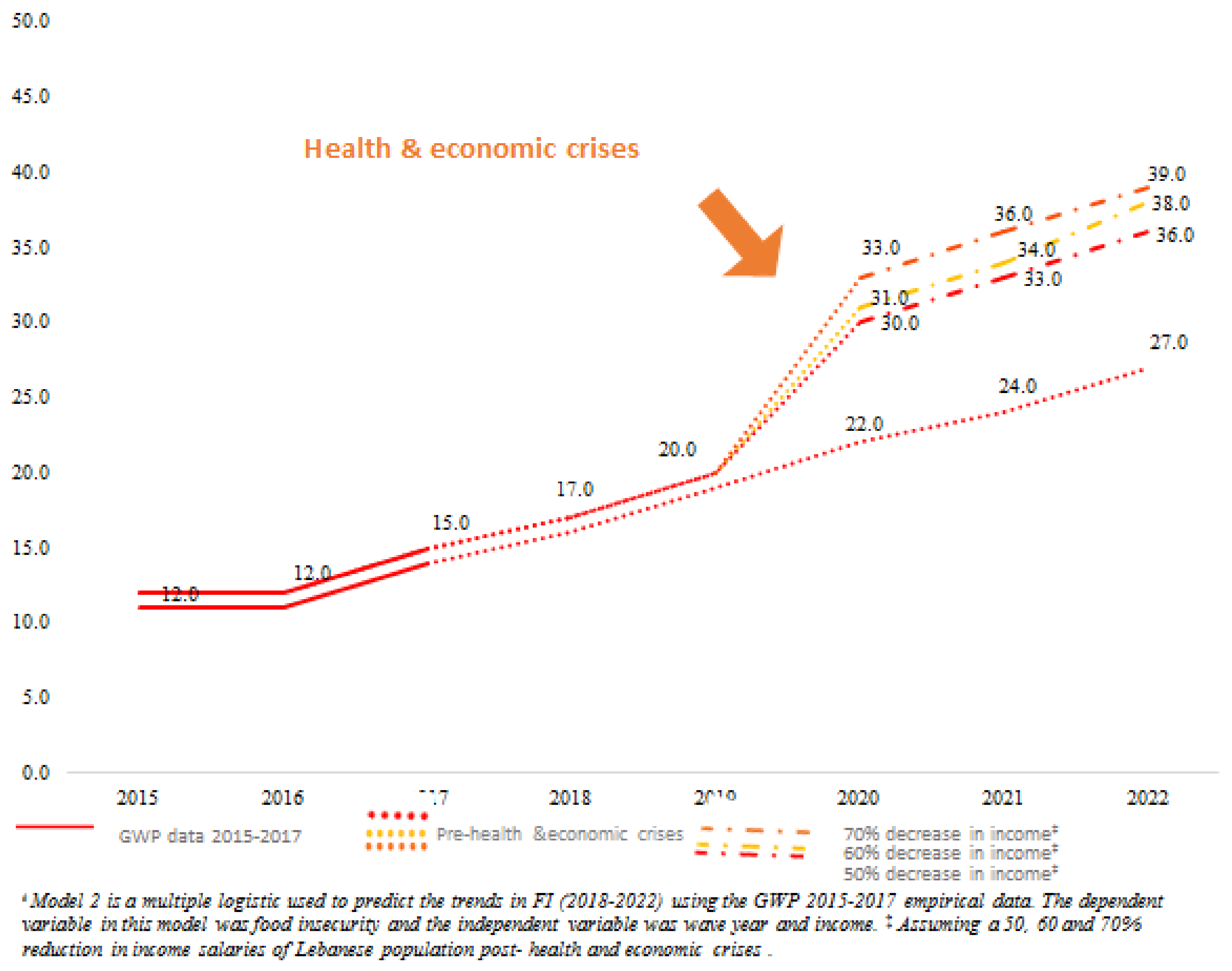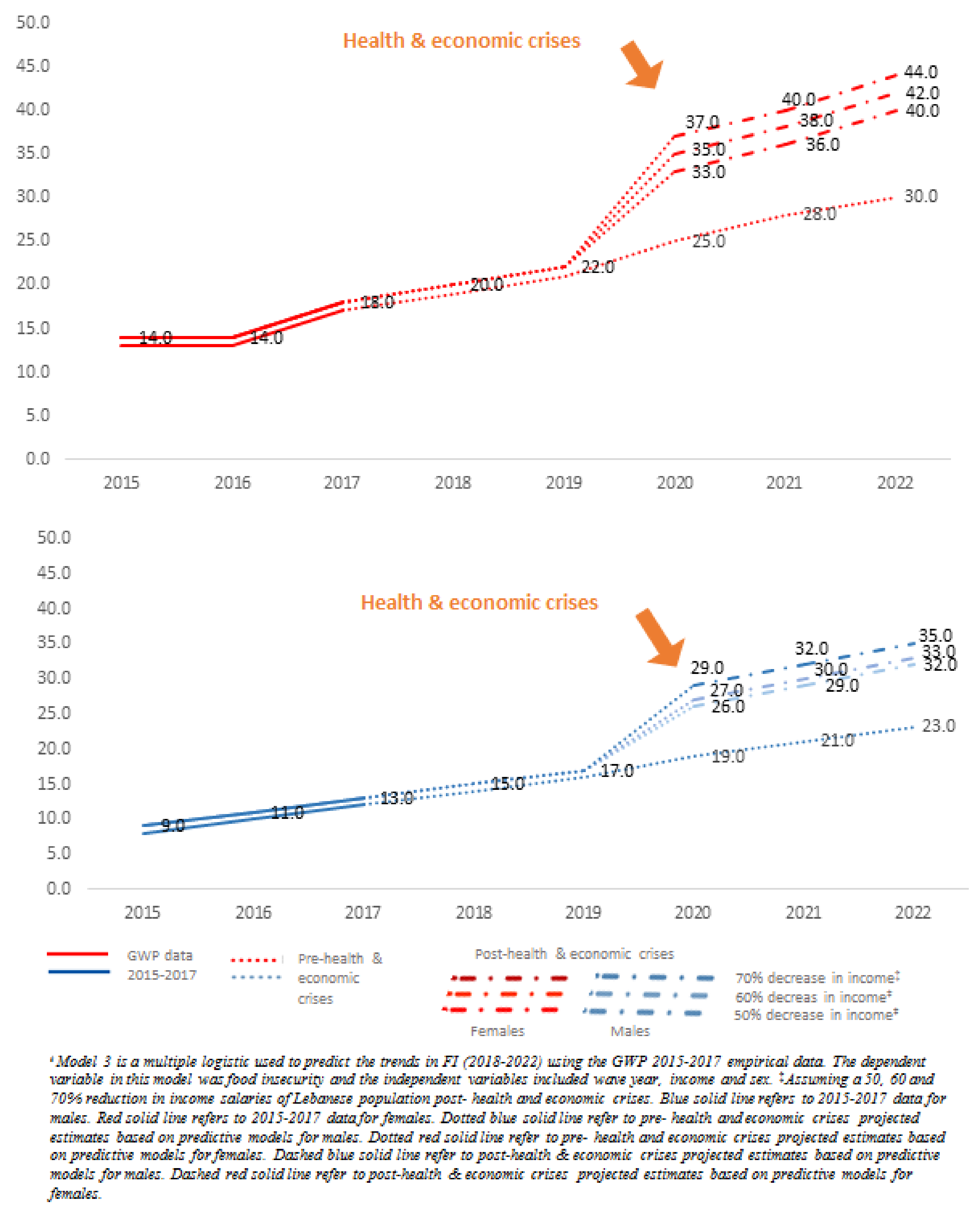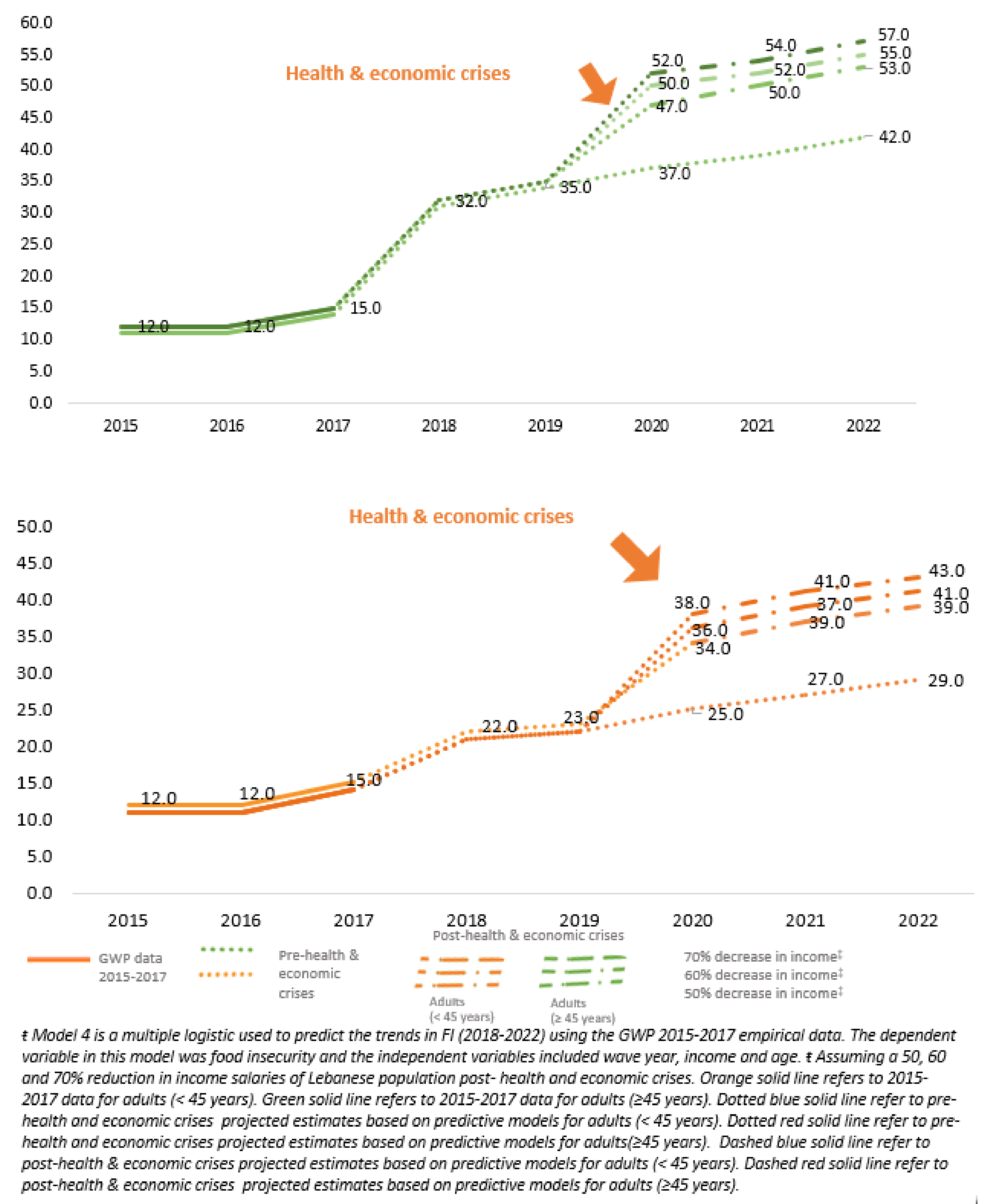Food Insecurity Pre- and Post the COVID-19 Pandemic and Economic Crisis in Lebanon: Prevalence and Projections
Abstract
:1. Introduction
2. Materials and Methods
2.1. Study Population
2.2. Food Security Measure
2.3. Sociodemographic and Economic Variables
2.4. Statistical Analysis
3. Results
4. Discussion
4.1. Recommendations and Potential Strategies for Alleviation of Food Insecurity in Lebanon
4.2. Strengths and Limitations
5. Conclusions
Author Contributions
Funding
Institutional Review Board Statement
Informed Consent Statement
Data Availability Statement
Conflicts of interest
References
- Nicola, M.; Alsafi, Z.; Sohrabi, C.; Kerwan, A.; Al-Jabir, A.; Iosifidis, C.; Agha, M.; Agha, R. The Socio-Economic Implications of the Coronavirus and COVID-19 Pandemic: A Review. Int. J. Surg. 2020. [Google Scholar] [CrossRef] [PubMed]
- World Bank. Decisive Action in an Unprecedented Crisis. Available online: https://www.worldbank.org/en/news/feature/2020/04/17/decisive-action-in-an-unprecedented-crisis (accessed on 11 May 2020).
- Mardones, F.O.; Rich, K.M.; Boden, L.A.; Moreno-Switt, A.I.; Caipo, M.L.; Zimin-Veselkoff, N.; Alateeqi, A.M.; Baltenweck, I. The COVID-19 Pandemic and Global Food Security. Front. Vet. Sci. 2020, 7. [Google Scholar] [CrossRef] [PubMed]
- ILO. COVID-19 and the World of Work: Impact and Policy Responses. Available online: https://www.ilo.org/wcmsp5/groups/public/---dgreports/---dcomm/documents/briefingnote/wcms_738753.pdf (accessed on 11 May 2020).
- ESCWA. COVID-19 Economic Cost to the Arab Region. Available online: https://www.unescwa.org/sites/www.unescwa.org/files/escwa-covid-19-economic-cost-arab-region-en.pdf (accessed on 11 May 2020).
- FAO. Novel Coronavirus (COVID-19). Available online: http://www.fao.org/2019-ncov/q-and-a/impact-on-food-and-agriculture/en/ (accessed on 11 May 2020).
- FAO. Impacts of COVID-19 on Food Security and Nutrition: Developing Effective Policy Responses to Address the Hunger and Malnutrition Pandemic. Available online: http://www.fao.org/3/cb1000en/cb1000en.pdf (accessed on 16 June 2021).
- Niles, M.T.; Bertmann, F.; Belarmino, E.H.; Wentworth, T.; Biehl, E.; Neff, R. The early food insecurity impacts of COVID-19. Nutrients 2020, 12, 2096. [Google Scholar] [CrossRef] [PubMed]
- World Bank. Food Security and COVID-19. Available online: https://www.worldbank.org/en/topic/agriculture/brief/food-security-and-covid-19 (accessed on 16 June 2021).
- Swinnen, J.; McDermott, J. Covid-19 and Global Food Security. EuroChoices 2020. [Google Scholar] [CrossRef]
- UN SG. Policy Brief: The Impact of COVID-19 on Food Security and Nutrition, June 2020. Available online: https://reliefweb.int/report/world/policy-brief-impact-covid-19-food-security-and-nutrition-june-2020 (accessed on 16 June 2021).
- Zurayk, R. Pandemic and Food Security. J. Agric. Food Syst. Community Dev. 2020, 9, 1–5. [Google Scholar] [CrossRef]
- UNESCO. Global Education Monitoring Report, 2019: Arab States: Migration, Displacement and Education: Building Bridges, not Walls. Available online: https://unesdoc.unesco.org/ark:/48223/pf0000371320 (accessed on 11 May 2020).
- UNHCR. UNHCR and League of Arab States Sign Agreement to Address Refugee Challenges in the Arab Region. Available online: https://www.unhcr.org/news/press/2017/9/59c4d7024/unhcr-league-arab-states-sign-agreement-address-refugee-challenges-arab.html (accessed on 11 May 2020).
- UNHCR. Refugees Across Arab World Feel Economic Pain of Coronavirus. Available online: https://www.unhcr.org/news/latest/2020/5/5eabcf704/refugees-across-arab-world-feel-economic-pain-coronavirus.html (accessed on 11 May 2020).
- WHO. COVID-19: Ensuring Refugees and Migrants Are not Left Behind. Available online: http://www.euro.who.int/en/health-topics/health-determinants/migration-and-health/news/news/2020/4/covid-19-ensuring-refugees-and-migrants-are-not-left-behind (accessed on 11 May 2020).
- ESCWA. Mitigating the Impact of COVID-19: Poverty and Food Insecurity in the Arab Region. Available online: https://www.unescwa.org/sites/www.unescwa.org/files/publications/files/20-00116_rer_mitigatingimpact_covid-19_eng_april8.pdf (accessed on 11 May 2020).
- FAO. COVID-19 and Its Impact Onfood Security in the Near East and North Africa: How to Respond? Available online: http://www.fao.org/3/ca8778en/CA8778EN.pdf (accessed on 11 May 2020).
- UNHCR. Lebanon. Available online: http://reporting.unhcr.org/node/2520 (accessed on 11 May 2020).
- Malaeb, B. State fragility in Lebanon: Proximate causes and sources of resilience. In International Growth Centre’s Commission on State Fragility, Growth and Development; IGC: London, UK, 2018. [Google Scholar]
- Collard, R. How Sectarianism Helped Destroy Lebanon’s Economy. Available online: https://foreignpolicy.com/2019/12/13/sectarianism-helped-destroy-lebanon-economy/ (accessed on 11 May 2020).
- Phillips, J.; Robinson, N. How COVID-19 Exacerbates Lebanon’s Mounting Economic, Political Woes. Available online: https://www.heritage.org/middle-east/commentary/how-covid-19-exacerbates-lebanons-mounting-economic-political-woes (accessed on 11 May 2020).
- World Bank. World Bank: Lebanon Is in the Midst of Economic, Financial and Social Hardship, Situation Could Get worse. Available online: https://www.worldbank.org/en/news/press-release/2019/11/06/world-bank-lebanon-is-in-the-midst-of-economic-financial-and-social-hardship-situation-could-get-worse (accessed on 11 May 2020).
- World Bank. Lebanon’s Economic Update—April 2020. Available online: https://www.worldbank.org/en/country/lebanon/publication/economic-update-april-2020 (accessed on 11 May 2020).
- ESCWA. ESCWA Warns: More than Half of Lebanon’s Population Trapped in Poverty. Available online: https://www.unescwa.org/news/Lebanon-poverty-2020 (accessed on 20 August 2020).
- WFP. Beirut Port Explosion: Impact on Key Economic and Food Security Indicators. Available online: https://reliefweb.int/report/lebanon/beirut-port-explosion-impact-key-economic-and-food-security-indicators-august-2020#:~:text=The%20effects%20of%20the%20explosion,according%20to%20the%20World%20Bank (accessed on 20 February 2021).
- AUB. Lebanon Food Security Portal. Available online: https://www.aub.edu.lb/fafs/foodsecurity/Pages/default.aspx (accessed on 16 June 2021).
- Jomaa, L.; Naja, F.; Kharroubi, S.; Hwalla, N. Prevalence and correlates of food insecurity among Lebanese households with children aged 4–18 years: Findings from a national cross-sectional study. Public Health Nutr. 2019, 22, 202–211. [Google Scholar] [CrossRef] [PubMed] [Green Version]
- Sheikomar, O.B.; Dean, W.; Ghattas, H.; Sahyoun, N.R. Validity of the Food Insecurity Experience Scale (FIES) for Use in League of Arab States (LAS) and Characteristics of Food Insecure Individuals by the Human Development Index (HDI). Curr. Dev. Nutr. 2021, 5, nzab017. [Google Scholar] [CrossRef] [PubMed]
- Ahmadi, D.; Melgar-Quiñonez, H. Determinants of food insecurity in occupied Palestinian territory: A cross-sectional survey. Lancet 2019, 393, S4. [Google Scholar] [CrossRef]
- Asfahani, F.; Kadiyala, S.; Ghattas, H. Food insecurity and subjective wellbeing among Arab youth living in varying contexts of political instability. J. Adolesc. Health 2019, 64, 70–78. [Google Scholar] [CrossRef] [PubMed] [Green Version]
- Gallup Inc. Worldwide Research Methdology and Codebook; Gallup Inc.: Washington, DC, USA, 2017. [Google Scholar]
- Ballard, T.; Kepple, A.; Cafiero, C. The Food Insecurity Experience Scale: Development of a Global Standard for Monitoring Hunger Worldwide; Food and Agriculture Organization: Rome, Italy, 2013; Available online: http://www.fao.org/fileadmin/templates/ess/voh/FIES_Technical_Paper_v1.1.pdf (accessed on 11 May 2020).
- FAO. GIEWS Country Brief Lebanon. Available online: http://www.fao.org/giews/countrybrief/country/LBN/pdf/LBN.pdf (accessed on 12 May 2020).
- WFP. Assessing the Impact of the Economic and COVID-19 Crises in Lebanon. Available online: https://docs.wfp.org/api/documents/WFP-0000116784/download/ (accessed on 5 July 2020).
- Omidvar, N.; Ahmadi, D.; Sinclair, K.; Melgar-Quiñonez, H. Food security in selected Middle East and North Africa (MENA) countries: An inter-country comparison. Food Secur. 2019, 11, 531–540. [Google Scholar] [CrossRef]
- El-Asmar, F.Z. Business Continuity Readiness: The Case of Lebanon-by Fadi Zouhair El-Asmar. Available online: https://scholarworks.aub.edu.lb/handle/10938/8673 (accessed on 11 May 2020).
- Hamadeh, S.; Tohme Tawk, S.; Abi-Said, M. Urban Agriculture and Food Security in the Middle Eastern Context: A Case Study from Lebanon and Jordan. In Food Security in the Middle East; Oxford University Press: Oxford, UK, 2014; pp. 158–184. [Google Scholar]
- Harrigan, J. An Economic Analysis of National Food Sovereignty Policies in the Middle East: The Case of Lebanon and Jordan. Available online: https://oxford.universitypressscholarship.com/view/10.1093/acprof:oso/9780199361786.001.0001/acprof-9780199361786-chapter-3 (accessed on 22 May 2021).
- Abosedra, S.; Fakih, A. Assessing the role of remittances and financial deepening in growth: The experience of Lebanon. Glob. Econ. J. 2017, 17. [Google Scholar] [CrossRef]
- World Bank. Droughts and Agriculture in Lebanon: Causes, Consequences, and Risk Management. Available online: http://documents.worldbank.org/curated/en/892381538415122088/pdf/130405-WP-P160212-Lebanon-WEB.pdf (accessed on 11 May 2020).
- World Bank. Lebanon Sinking into One of the Most Severe Global Crises Episodes, amidst Deliberate Inaction. Available online: https://www.worldbank.org/en/news/press-release/2021/05/01/lebanon-sinking-into-one-of-the-most-severe-global-crises-episodes (accessed on 13 August 2021).
- Statista. The 20 Countries with the Highest Inflation Rate in 2020 (Compared to the Previous Year). Available online: https://www.statista.com/statistics/268225/countries-with-the-highest-inflation-rate/ (accessed on 13 August 2021).
- WFP. 2020—Global Report on Food Crises. Available online: https://www.wfp.org/publications/2020-global-report-food-crises (accessed on 13 August 2021).
- Broussard, N.H. What explains gender differences in food insecurity? Food Policy 2019, 83, 180–194. [Google Scholar] [CrossRef]
- Jomaa, L.; Naja, F.; Cheaib, R.; Hwalla, N. Household food insecurity is associated with a higher burden of obesity and risk of dietary inadequacies among mothers in Beirut, Lebanon. BMC Public Health 2017, 17, 567. [Google Scholar] [CrossRef]
- Sinclair, K.; Ahmadigheidari, D.; Dallmann, D.; Miller, M.; Melgar-Quiñonez, H. Rural women: Most likely to experience food insecurity and poor health in low-and middle-income countries. Glob. Food Secur. 2019, 23, 104–115. [Google Scholar] [CrossRef]
- Omidvar, N.; Ghazi-Tabatabie, M.; Sadeghi, R.; Mohammadi, F.; Abbasi-Shavazi, M.J. Food insecurity and its sociodemographic correlates among Afghan immigrants in Iran. J. Health Popul. Nutr. 2013, 31, 356. [Google Scholar] [CrossRef] [Green Version]
- ESCWA. Strategic Review of Food and Nutrition Security in Lebanon. Available online: https://data2.unhcr.org/en/documents/download/53292 (accessed on 12 May 2020).
- Ministry of Agriculture. Ministry of Agriculture Emergency Plan, April 2020. Available online: https://english.alarabiya.net/en/features/2020/04/30/Lebanese-emergency-agriculture-plan-leaves-questions-unanswered (accessed on 12 May 2020).
- Carnegie. Lebanon’s Economic Crisis: A Ten Point Action Plan for Avoiding a Lost Decade. Available online: https://carnegie-mec.org/2020/01/06/lebanon-s-economic-crisis-ten-point-action-plan-for-avoiding-lost-decade-pub-80704 (accessed on 11 May 2020).
- BlomInvest. Lebanon’s Inflation Hits Record High at 147.55% as Food Prices Soar 395% by January 2021. Available online: https://blog.blominvestbank.com/39991/lebanons-inflation-hits-record-high-at-197-55-as-food-prices-soar-395-by-january-2021/#:~:text=by%20January%202021-,Lebanon’s%20Inflation%20Hits%20Record%20High%20at%20147.55%25%20as%20Food,Soar%20395%25%20by%20January%202021&text=Inflation%20rate%20in%20January%202021,increased%20over%20the%20studied%20period (accessed on 10 June 2021).
- Ministry of Social Affairs. The National Poverty Targeting Program. Available online: http://nptp.pcm.gov.lb/ (accessed on 12 May 2020).
- UNHCR-WFP. UNHCR and WFP Thank the EU for Continued Support to Vital Cash Programme for Vulnerable Syrian Refugees in Lebanon. Available online: https://www.wfp.org/news/unhcr-and-wfp-thank-eu-continued-support-vital-cash-programme-vulnerable-syrian-refugees (accessed on 12 May 2020).
- UNOCHA. Global Humanitarian Response Plan COVID-19: United Nations Coordinated Appeal April-December 2020. Available online: https://www.unocha.org/sites/unocha/files/Global-Humanitarian-Response-Plan-COVID-19.pdf (accessed on 12 May 2020).
- GoL-UNHCR. Food Security and Agriculture 2019 End-Year Dashboard. Available online: https://reliefweb.int/sites/reliefweb.int/files/resources/75944-2.pdf (accessed on 12 May 2020).
- Chua, G.; Yuen, K.F.; Wang, X.; Wong, Y.D. The Determinants of Panic Buying during COVID-19. Int. J. Environ. Res. Public Health 2021, 18, 3247. [Google Scholar] [CrossRef] [PubMed]
- Haddad, L.; Fanzo, J.; Godfrey, S.; Hawkes, C.; Morris, S.; Neufeld, L. The COVID-19 Crisis and Food Systems: Addressing Threats, Creating Opportunities. Available online: https://www.gainhealth.org/sites/default/files/news/documents/covid-19-crisis-and-food-systems-probable-impacts-and-potential-mitigation-and-adaptation-responses.pdf (accessed on 11 May 2020).
- High-Level Panel of Experts on Food Security and nutrition (HLPE). Impact of COVID-19 on Food Security and Nutrition (FSN). Available online: https://ec.europa.eu/knowledge4policy/publication/impact-covid-19-food-security-nutrition-fsn_en (accessed on 12 May 2020).




| Food Security Status | Logistic Regression | |||||
|---|---|---|---|---|---|---|
| Total Sample n (%) | Food Secure n (%) | Food Insecure n (%) | p-Value | Unadjusted OR | Adjusted OR ‡ | |
| Year | 0.041 | |||||
| 2015 | 1000 (33.30) | 883 (88.30) | 117 (11.70) | 1.0 | 1.0 | |
| 2016 | 1000 (33.30) | 876 (87.60) | 124 (12.40) | 1.07 (0.82,1.40) | 1.05 (0.80,1.40) | |
| 2017 | 1000 (33.30) | 847 (84.70) | 153 (15.30) | 1.36 (1.05,1.76) | 1.33 (1.02,1.75) | |
| p-trend | 0.0172 | 0.1119 | ||||
| Female | 1525 (50.83) | 1291 (49.54) | 234 (59.39) | <0.001 | 1.49 (1.20,1.85) | 1.67 (1.30,2.16) |
| Married | 1668 (55.64) | 1444 (55.43) | 224 (57.00) | 0.560 | 1.07 (0.86,1.32) | - |
| Age (years) | <0.001 | |||||
| 15–24 years | 597 (19.92) | 547 (20.99) | 50 (12.69) | 1.0 | 1.0 | |
| 25–34 years | 668 (22.27) | 586 (22.49) | 82 (20.81) | 1.53 (1.06,2.22) | 1.64 (1.10,2.42) | |
| 35–44 years | 633 (21.10) | 553 (21.22) | 80 (20.30) | 1.58 (1.09,2.30) | 1.36 (0.92,2.01) | |
| 45–54 years | 502 (16.73) | 418 (16.04) | 84 (21.32) | 2.20 (1.51,3.19) | 2.05 (1.40,3.04) | |
| >54 years | 600 (20.00) | 502 (19.26) | 98 (24.87) | 2.13 (1.49,3.06) | 2.28 (1.54,3.38) | |
| p-trend | <0.001 | <0.001 | ||||
| Educational Level | <0.001 | |||||
| Elementary or less | 667 (22.24) | 531 (20.38) | 136 (34.52) | 1.0 | 1.0 | |
| Secondary | 1687 (26.25) | 1479 (56.78) | 208 (52.79) | 0.55 (0.43,0.70) | 0.73 (0.57,0.95) | |
| Tertiary (university or higher) | 645 (21.51) | 595 (22.84) | 50 (12.69) | 0.33 (0.23,0.46) | 0.55 (0.37,0.81) | |
| p-trend | <0.001 | 0.001 | ||||
| Employment | 0.043 | |||||
| Unemployed | 1223 (40.77) | 1044 (40.06) | 179 (45.43) | 1.0 | 1.0 | |
| Employed | 1777 (59.23) | 1562 (59.94) | 215 (54.57) | 0.80 (0.65,0.99) | 1.19 (0.92,1.54) | |
| Income (International Dollars) | 0.001 | |||||
| Poorest 20% | 498 (16.60) | 371 (14.24) | 127 (32.23) | 1.0 | 1.0 | |
| Second 20% | 533 (17.77) | 442 (16.96) | 91 (23.10) | 0.60 (0.44,0.81) | 0.65 (0.47,0.88) | |
| Middle 20% | 573 (19.10) | 501 (19.22) | 72 (18.27) | 0.42 (0.30,0.58) | 0.42 (0.30,0.59) | |
| Fourth 20% | 654 (21.80) | 592 (22.72) | 62 (15.74) | 0.31 (0.22,0.43) | 0.33 (0.23,0.46) | |
| Richest 20% | 742 (24.73) | 700 (26.86) | 42 (10.66) | 0.17 (0.12,0.25) | 0.18 (0.12,0.28) | |
| p-trend | <0.001 | <0.001 | ||||
Publisher’s Note: MDPI stays neutral with regard to jurisdictional claims in published maps and institutional affiliations. |
© 2021 by the authors. Licensee MDPI, Basel, Switzerland. This article is an open access article distributed under the terms and conditions of the Creative Commons Attribution (CC BY) license (https://creativecommons.org/licenses/by/4.0/).
Share and Cite
Kharroubi, S.; Naja, F.; Diab-El-Harake, M.; Jomaa, L. Food Insecurity Pre- and Post the COVID-19 Pandemic and Economic Crisis in Lebanon: Prevalence and Projections. Nutrients 2021, 13, 2976. https://doi.org/10.3390/nu13092976
Kharroubi S, Naja F, Diab-El-Harake M, Jomaa L. Food Insecurity Pre- and Post the COVID-19 Pandemic and Economic Crisis in Lebanon: Prevalence and Projections. Nutrients. 2021; 13(9):2976. https://doi.org/10.3390/nu13092976
Chicago/Turabian StyleKharroubi, Samer, Farah Naja, Marwa Diab-El-Harake, and Lamis Jomaa. 2021. "Food Insecurity Pre- and Post the COVID-19 Pandemic and Economic Crisis in Lebanon: Prevalence and Projections" Nutrients 13, no. 9: 2976. https://doi.org/10.3390/nu13092976
APA StyleKharroubi, S., Naja, F., Diab-El-Harake, M., & Jomaa, L. (2021). Food Insecurity Pre- and Post the COVID-19 Pandemic and Economic Crisis in Lebanon: Prevalence and Projections. Nutrients, 13(9), 2976. https://doi.org/10.3390/nu13092976







